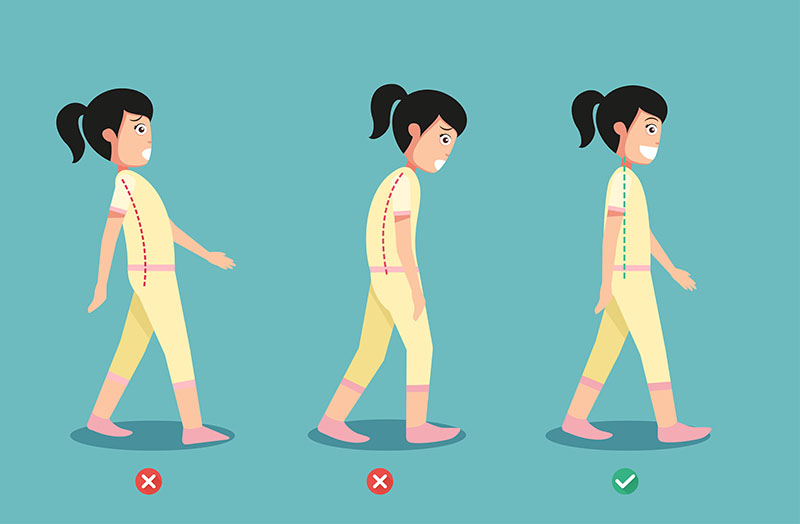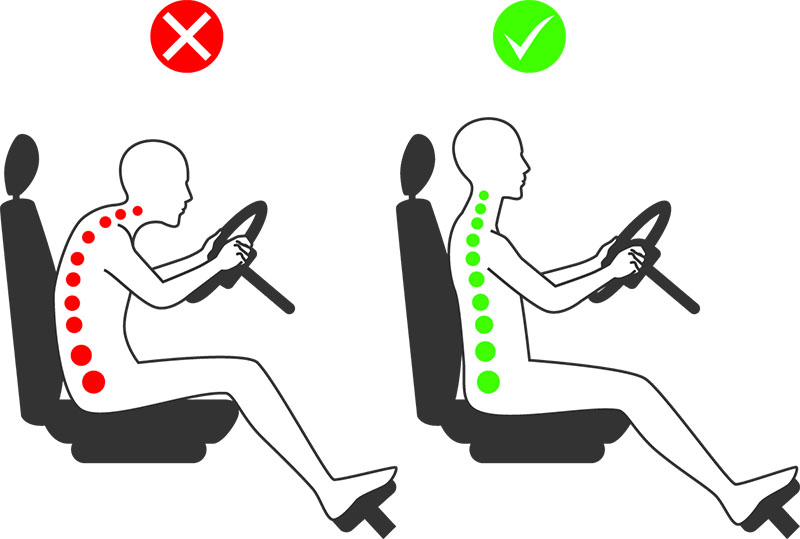By health writer, Karen Evennett.
Most of us don’t give a second thought to the way we use our body when we’re walking, sitting, or lying down. But, if bad habits are allowed to creep in, these most basic activities have the potential to cause long term postural problems that can eventually result in joint and muscle pain. Here are some examples of healthy daily habits that prevent joint and muscle pain.

Walk this way…
Walking helps strengthen the muscles that protect your joints, while also providing relief for joint pain and stiffness and should become one of your key healthy daily habits.
. Wear comfortable trainers with a broad toe area. These will give the muscles and joints in your feet room to stretch and move. You need to be able to use each part of your foot in turn, pushing through from your toes.
. Lift your hips, imagining that they’re carrying a tray bearing two glasses of wine – one balanced on each hip-bone as you walk. This flattens your abdomen and helps you use the muscles in your bum, which in turn protects you from hip and knee pain.
. Keep your head level, without jutting it forward. Imagine you’re wearing very long dangly earrings and you’re trying to prevent them from brushing against your shoulders.
. Swing your arms like pendulums – don’t pump them like a power walker. Power walking stiffens your joints by compressing your body. Swinging your arms loosens potentially painful joints instead of tightening them up.
. If you’re walking your dog, keep him on a short lead to prevent him pulling (which could hurt your back). The longer the lead, the more scope there is for your dog to pull and cause you to suffer a joint or muscle injury. Don’t wrap the lead around your wrist or fingers – they could be twisted by a sudden tug. Instead, hold the lead firmly in the palm of your hand like a tennis racket.
Please be seated…
On average we spend 9 ½ hours a day seated – at desks, in cars, and on the sofa – but sitting is one of the leading causes of lower back pain. This is because it’s our natural inclination to slouch, and when we slouch we put pressure on our spine, forcing it into a C shape instead of a healthy S shape that keeps it pain free. If you can’t avoid so much time sitting, be mindful of possible healthy daily habits and at least think about how you sit and what you can change.
. Think about your pelvis. The key to good seated posture is to imagine your pelvis is a bowl of water that you’re trying not to spill. If you can maintain this stability, you will stop your spine from slumping, and this will help to prevent painful joints and muscles in your back.
. In your office chair, push your hips as far back as you can, with your feet flat on the floor (or on a block) and your knees at the same height or slightly lower than your hips.
. On the sofa, resist the urge to slump, flop, or curl. How you sit in your downtime is just as important as how you sit at your desk. Sit upright, using cushions as props if you have a deep sofa, and position yourself so that your feet are flat on the floor and your knees no higher than your hips.

. When you’re driving, pull your seat far enough forward so that your knees can remain a little bent even when you’re fully pressing on the brake or clutch pedal. Keep your backrest slightly tilted and try to keep your shoulders touching the back of the seat when you’re steering. Avoid hunching forward, which will create tension in your shoulders.
Live and let lie…
Whatever else you’ve been doing all day, spending time on your back is one of the best ways to undo any compression that’s crept in along the way. Do it mindfully, following the rules of what teachers of the Alexander Technique call the Semi-Supine posture.
All you need to do is lie on the floor, with your head on a couple of paperback books wrapped in a soft towel. Keeping your head off the ground like this is important to maintain its natural position on top of your spine. (If you had your back against a wall, your head would be slightly forward of the wall – this is the posture you’re aiming to replicate.)
Raise your knees (to take pressure off your back), and place your feet firmly on the floor, at a distance from your bottom that puts your legs into a v-shape.
Keep your eyes open and your awareness in the room around you, rather than using this as an opportunity to drift off into a daydream.
This is a good neutral position in which to become aware of tension and allow yourself to release it. If you have the space, try spreading your arms out, hands facing upwards. It’s a great way to open the front of your chest, and especially useful if you’ve been hunched over a desk all day.
Alexander teachers recommend we all go semi-supine for 15 minutes a day. It’s a challenge if you have a fidgety mind, but it is a great way to look after your joints.
You could also try Phynova Joint and Muscle Pain Relief Tablets, a traditional herbal medicinal produced used for the relief of: backache, minor sports injuries, rheumatic or muscular pains, and general aches and pains in the muscles and joints based on traditional use only. Click here to find out more.

